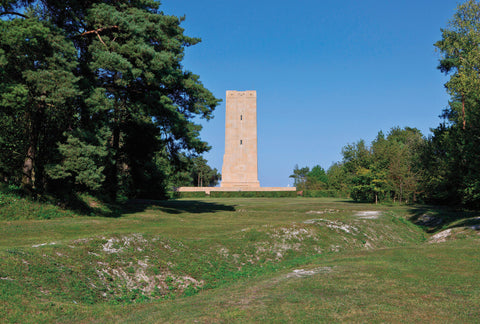
Hallowed Ground: Americans vs. Germans at Blanc Mont Ridge
The U.S. 2nd Infantry Division’s capture of heavily defended German positions on France’s Blanc Mont Ridge on Oct. 3–10, 1918, was the most skillfully executed American divisional attack of World War I. Under the command of Marine Maj. Gen. John A. Lejeune, leathernecks of the 4th Marine Brigade and doughboys of the 3rd Infantry Brigade achieved a far more influential strategic victory at Blanc Mont than they had at Belleau Wood that June. Yet Blanc Mont is one of the least remembered battles fought by the American Expeditionary Forces (AEF) during World War I.
(Map by Brian Walker)
Among the reasons it was forgotten is that it took place under French overall operational control and in the sector of the French Fourth Army, well west of the American Meuse-Argonne sector. When the AEF under Gen. John J. Pershing attacked northward on September 26 to break the German Siegfried Line (aka Hindenburg Line) in the Meuse-Argonne, the French Fourth Army west of the Argonne Forest had the mission of attacking to cover the advancing American left flank. The French drive quickly bogged down in front of the heavy defenses on Blanc Mont Ridge. Unable to move, the French commanders asked Pershing for a loan of troops to break the deadlock. With his left flank metaphorically hanging in the air, Pershing had little choice.
Pershing sent the veteran 2nd Division and an attached brigade of the green 36th Division. The French intended simply to plug the Americans into gaps in their line as individual replacements. Lejeune refused to have any part of that. He demanded they let him plan and execute the attack on the ridge his own way while giving him adequate flank support. The French were displeased, but they were desperate. Lejeune’s plan featured innovative tactics the French considered nothing short of insanity. For one, Lejeune’s two brigades assumed positions in the line with a mile-wide gap between them. The line bent slightly inward at that point, and Lejeune planned a converging attack that would pinch out the gap some 12,000 feet from the line of departure, just short of the main German positions atop the ridge.
Lejeune also planned for a phased, set-piece battle. Following short advances, the infantry would consolidate while artillery moved up to support the next phase of the advance. His methodical approach was a direct departure from the infantry dominant, continuous advance, open warfare tactics championed by Pershing as a remedy for the conflict’s four long years of stagnant trench warfare.
A 1919 painting by George
M. Harding depicts the fierce hand-to-hand combat that characterized the
fighting for Blanc Mont Ridge. (Naval History and Heritage Command)
Against all the pessimistic expectations of the French and AEF senior leaders, Lejeune’s plan worked. Although the fighting was heavy and costly, the 2nd Division took the ridge, held it for several days against fierce German counterattacks and then continued the advance northward. Finally, on the morning of October 10, the Germans began a general withdrawal north to the line of the Aisne River. The Siegfried Line in the Champagne sector was broken—although for the time being it held fast in the American sector between the Argonne and the Meuse.
The 2nd Division sustained 4,821 casualties at Blanc Mont, roughly half the total losses at Belleau Wood, but within seven days of fighting as opposed to 20. Also unlike the fighting at Belleau Wood, American forces at Blanc Mont employed a combination of skillful combined-arms warfare and intensive artillery support. Regardless, when Lejeune’s division returned to American operational control, it drew stern official criticism from the AEF’s inspector general, Maj. Gen. Andre W. Brewster, for failure to follow established American tactical doctrine—irrespective of the actual battlefield success. That was another reason Pershing gave the battle short shrift in his postwar memoirs.
After the war the American Battle Monuments Commission (ABMC) constructed a number of impressive monuments on many of the AEF’s battlefields. The one on Blanc Mont Ridge, the Sommepy American Monument, incorporates remnants of the original German trench lines. More than a century after the war the ABMC beautifully maintains all of its monuments. But Blanc Mont is a rather lonely place. Present-day visitors to AEF battlefields in France tend to focus on monuments in the Marne sector, or those between the Argonne and the Meuse. On any given day visitors to Blanc Mont might well have the entire place to themselves. It is a battle that deserves to be better remembered.
this article first appeared in Military History magazine
Facebook @MilitaryHistoryMagazine | Twitter @MilHistoryMag
